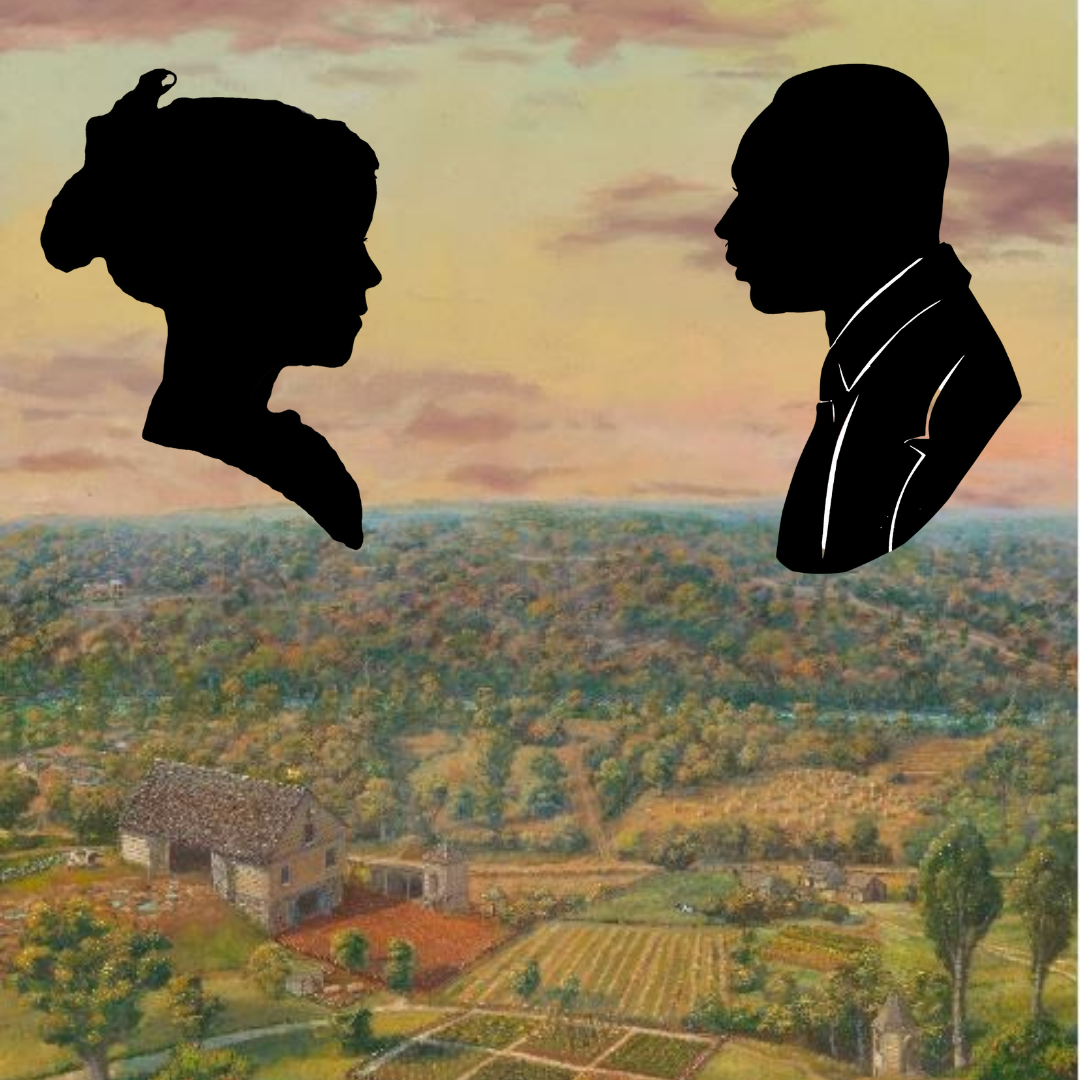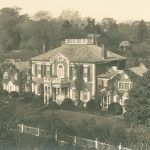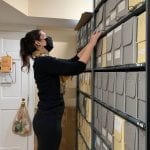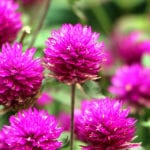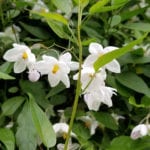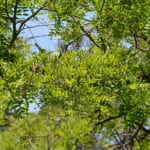
For over a decade interns, volunteers, and staff at Dumbarton House have been researching the question—did the Nourse family have any enslaved workers or indentured servants in their household? If so, who were these individuals? What were their lives like?
As many historical researchers know, with a project like this, the first place to start is in the museum archives. Over time, Dumbarton House has collected volumes of correspondence from among the Nourse family and their community that allows us some insight into both the enslaved people and the servants (indentured or freed) whose labor made the Nourse household run. These letters contain tantalizing fragments, hints of life in the early 1800s. Using these clues and primary sources in other museums and libraries, we can try to piece together who lived and worked for the Nourse family when they lived at this property, then referred to as “Mr. Jackson’s house on Cedar Hill.”

As the farthest point upstream that oceangoing boats could navigate, Georgetown became a bustling port town in the 1750s, predating the capital and creation of the District of Columbia. It was one of the largest tobacco ports in the country and a center of the American slave trade. Black men and women, both free and enslaved, formed approximately one-third of Georgetown’s population in 1800. Though no better than life on a large plantation, slavery in urban areas was practiced differently. The enslaved and indentured servants here worked the farm and were hired out to help on other farms in the area. Some lived on the property in cabins, though enslaved domestic workers would most likely have slept on mats on the floor of the hallway or above the kitchen. Life in the city also provided more opportunities for the enslaved and indentured workers to know people outside of their household, including freed Black people, due to the urban environment. Free and enslaved Black people met in the marketplace, on the canal, and in church.
We know from census records and the museum archives that Joseph Nourse had both enslaved and “free colored males and females” workers within his household from at least 1785-1840, including the time period the Nourse family lived at Dumbarton House (1804-1813). In researching the lives of the indentured and enslaved people at Dumbarton House, we think there were 10-13 individuals, but we know very little about their lives outside of the Nourses’ perspective. For some of these people, we do not even know if they were free or enslaved, white or Black. In this article, you can read everything we know about Dinah, Bacchus, Jane, Juba, and the other enslaved and indentured workers who are part of Dumbarton House’s long and complex history.
Dinah
Dinah was part of the Nourse household, according to the Nourse letters, for at least 25 years. She was with the family in Philadelphia and made the trip with them to Washington when it became our nation’s capital. Most of the letters refer to her cooking and preparing meals, which we believe was her role in the household. To supply the table, Dinah, the enslaved cook, used vegetables and herbs from the kitchen garden. We have letters that state, “Richard came down yesterday with a bag of apples which Dinah is pairing to be dined” (from Maria Nourse to her son, Charles, 1803) and “Dinah [is making] fried bacon, an apple dumpling or a rice pudding” (from Maria Nourse to her husband, Joseph, 1804).

In 1805, Joseph wrote about Dinah leaving the property without permission:
Dinah the day after you left home took it into her head to leave her Child and ramble … made enquires but without affect. You Mother will hardly be induced to receive her again and it is not improbable but that the State of Georgia may receive an acquisition in an able bodied Slave—the leaving of her Childrens is an evidence of her wickedness that is not common even among her complexion.
Joseph to his son Charles (August 17, 1805)
While we are unsure of the repercussions of her actions, Dinah continued to appear in family correspondence through 1810. For instance, in 1808, Joseph wrote to his wife: “Dinah has a complaint for which she sued you used to give her a … warm … Pepper steeped in Whiskey—this he took this morning with effects as … told me—the Dr. has not yet returned” (June 6, 1808).
Why might Dinah have decided to run in 1805? In his letter, is Joseph threatening to sell Dinah south or expressing concern about her vulnerability to slave catchers? We can only wonder how the threat of being sold further south might have affected her and other enslaved workers in the household. Lacking firsthand accounts from people like Dinah will always mean there are gaps in our history.
Joseph expressed his thoughts about punishing enslaved people in another letter five years later:
Mr. Laurie not a little perplexed—their mulatto girl young as she is, pregnant, and so impudent, that they could not keep her. A man from the Country purchased her in the presence of Mr. Magowan and Mrs. Magowan for $200 promising not to sell her again to any person who would buy her to carry her to Georgia, but to day he heard the Man he had sold her to is in that traffic—however he is going 10 Miles to see after the purchaser, & try to get her back.
Joseph to his wife Maria, (October 10, 1810)
Bacchus
Bacchus was a man who was in the Nourse household from 1785-1809. He is first mentioned in a letter of 1785, when the Nourses were living in Philadelphia. Quotes suggest that the Nourses sent him out on numerous trips: “I am anxious about so much as a Servant, they are so difficult to be had, that I wish Dinah may be sent along with…Bachus” (from Joseph Nourse to Maria, Sunday May 15th 1785) and “the progress of your journey and yourself, and daughters with your sick man Backus and your two Escorts the men agreeable to me please to direct to me in Georgetown” (from Joseph to Maria, July 30, 1804).
In a telling letter to Maria from Sarah, who we believe is Maria’s sister, they discuss Bacchus and the institutionalized racism of slavery.
Who among us would be industrious if convinced he should always remain poor, who cherish the social virtues convinced of the impossibility of calling them into action or attaining by their mains respectability in life? Our own colour in all new country’s have been discovered rude and savage, these unhappy people must forever continue in that state, whilst it is the barbarous policy of our states to keep them in ignorance to make them serviceable slaves. I once thought differently, but now feel a conviction that their many vices belong not to their nature, but their situation. From their treatment in the south in states we may calculate on an insurrection not far off and from their numbers, and unenlightened minds, the carnage and devastation dreadful. Men must fight with fury who are in so despairing a situation as to have nothing to lose, all to gain by their courage, certain death awaiting in the failure of their enterprise. I ask pardon for intruding this melancholy picture on your view, it is one that has made a striking impression on my mind…
(September 27, 1797)
These letters give us a glimpse into the feelings and emotions Sarah had regarding slavery in relation to Bacchus. Joseph wrote about his concerns for Bachus as well, “I have often thought of poor Bachus—I hope he will not forget my praying with him & for him—he cannot forget his Miss Sephas kind attention: Your servants here were all at Church—too many whites were absent” (Joseph to Maria, August 5, 1804). From this quote, it is clear that Black people and white people attended church together in Georgetown.
Jane
Jane was in charge of many different household duties: cooking, sewing, and handling some of the household financial accounts. In family letters between Joseph, Charles, and Maria, we hear a bit about Jane’s work in the kitchen: “please give Jane half a pack of young small French green beans to pickle before you come away…” Mentions of Jane’s involvement with the household accounts include: “Jane counted her cash on hand today, and debts outstanding for butter etc. this week, and it stands at about 19 pounds of butter” and “Jane is to give me a weekly account of sales to be sent to you.” Lastly, Maria mentions Jane’s sewing alongside the names of other people working on the property: “I purchased 10 yards of linen…which Jane has amused herself with making a covering for Dinah’s back and Juba and Frank’s legs.” These four letters date from 1796 through 1805.
We are uncertain whether Jane was white or Black, free, indentured, or enslaved.
Juba
Juba’s duties, for the most part, occurred outside of the home. He is mentioned working in the garden, as well as escorting Maria Nourse and her daughter on at least one trip. In letters between Maria and Joseph, Maria states, “Juba can bring Jane a pint worth of milk every morning from market…” And Charles writes to his mother “I have determined to send you this by your trusty servant Juba…” and “Fran and D. are going to do wonders in the garden—and Juba[‘s] work will astonish you.” These letters are from circa 1804. In 1805, Charles refers to Juba’s work making seams for shoes, suggesting that he had training as a cobbler, which he practiced along with his other work.
Frank

Frank was Joseph Nourse’s “Man servant,” assisting him with daily tasks. Unfortunately, little else is known about Frank. Below are listed all of the quotes that mention Frank in the Nourse’s family letters.
“Mr. Frank was I suppose the better for his Masters want of appetite, and I … on the influence of good company, a kind Cook, a thought on what you please on the organs of digestion.”
Joseph to Maria (August 1, 1804)
“I have by discretion had two eggs, fried bacon, cabbage Potatoes corn apple dumpling, and today boiled Rice, as good a dinner as I would ever wish to sit down to: but this with only Frank gives no relish.”
Joseph to Maria (August 2, 1804)
“I am now telling my man Frank to get the water”
Joseph to Maria, (August 2, 1804)
Fran
Fran helped Dinah in the kitchen, including tending the kitchen garden which supplied the Nourse family dinner table, and shopping at the market. Below are all the mentions Joseph made about Fran and her work.
Fran came home last evening with her … in good time. Mrs. Said she was to be informed how many yards in the …”
Joseph to Maria (August 1, 1804)
Fran went after market to the place and is … returning…Fran has returned with the butter kettle and tin pan full of blackberries. I told her I would mention this to you…
Joseph to Maria (August 2, 1804)
Fran has supplied the Table daily with Cabbage, Potatoes, occasionally Corn, 2 eggs…It now rains plentifully, and tomorrow Fran is to be all attention to the Cellery
Joseph to Maria (August 5, 1804)

Polly, Peter, Will, and Betsy are mentioned in passing as working in the field and house, but no details are known about their lives beyond the snippets from the Nourse’s letters below.
I should have mentioned that she is now partaking of a fine chicken one of four Polly had ready for us.
Joseph to Charles (April 25, 1805)
“Peter is preparing ground for Turneps
Joseph to Maria (August 2, 1804)
Peter has been brought home and will soon be about again.
Joseph to Charles (August 17, 1805)
Your affairs go on as well perhaps as they could do in your absence Dinah much engaged in her business, and quiet—the girls without noise, & Betsy pursues the harmless tenor of her way without complaining any. Little Will, does as little as may be, but his master may do better with him—he gave him some wood as a … at home … Will is the same Will
Joseph to Maria (October 10, 1810)
Joseph Nourse hired individuals to help with specific tasks or for short periods of time. These people include Richard, who brought wood and apples to the house, Daniel, who drove a carriage for hire, and Black Peter, who was hired to plough the fields. Quotes are as follows:
Richard came down yesterday with a bag of apples which Dinah is pairing for to be dined—he brought a good load of wood, which He has repeated today with another bag of Apples, and carried 5 loads to Lynchburg-he will be down again tomorrow.
Joseph to Maria (August 2, 1804)
I have hired Daniel for the day to go over and bring down the best Carriage—and forward this Letter by some Gentleman going up to Winchester.
Joseph to Maria (September 6, 1814)
The Potatoes on this day receiving the Plough of Black Peter, who brought down the butter from Dollys, this morning—this same black Peter is an industrious fellow.
Jospeh to Maria (August 10, 1804)
Joseph Nourse moved away from Dumbarton House in 1813, eventually ending up at Mount Alban, a property on the land where the National Cathedral sits today. While we are unsure whether he continued to enslave Black individuals at his new home, we do know he purchased a family for his son Charles and Charles’ bride Rebecca Morris, who lived up on Wisconsin Avenue in a home called Highlands (now the administrative building for the Sidwell Friends School). An 1827 bill of sale in our archives describes this purchase of a thirty-five-year-old enslaved woman named Ann and her five children, William, Lee, Samuel, Ann, and Nathan from Walter Brooke Beale.

Mark Auslander, a university professor, has conducted extensive research on the family. By 1850, William, one of the children mentioned in the bill of sale, was a free man of color, employed as a coachman at The Highlands. He purchased the freedom of his wife Sarah and their five children, and after the Civil War they settled in Tenleytown, DC. More can be read in this article.
Although written evidence of many enslaved people’s lives is often scarce, research continues through archaeological work, piecing together documents, and filling in the gaps in partnership with other Georgetown organizations. Each piece of information helps us see a fuller view of history and appreciate the many diverse individuals who are a part of Dumbarton House’s past. There will be future blog posts that further explore the history of African Americans within Georgetown, whether free or enslaved.
Many thanks for the contributions of staff, volunteers, and docents without whom this research could not have been done, including Christopher Celauro (past Docent, Museum Teacher and Database Administrator) and Stephanie Boyle, (past Director of Education) who wrote an earlier version of this article.

